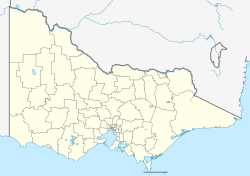Yelta | |||||
|---|---|---|---|---|---|
| General information | |||||
| Coordinates | 34°07′41″S141°59′38″E / 34.1280°S 141.9938°E | ||||
| Line | Yelta | ||||
| Platforms | 0, formerly 1 | ||||
| Tracks | 1 with runaround loop | ||||
| Other information | |||||
| Status | Closed | ||||
| History | |||||
| Opened | 1925 | ||||
| Closed | September 12, 1993 | ||||
| |||||
Yelta was a small railway station located on the Yelta railway line, in the small township of Yelta, Victoria. It once had a medium-sized platform, which was demolished around 2004.[ citation needed ]
Early on, traffic was not sufficient to have a station master present, [1] with sheep gates added to the passenger platform to allow for easier transport of sheep from the north in later years. [2] [3]
